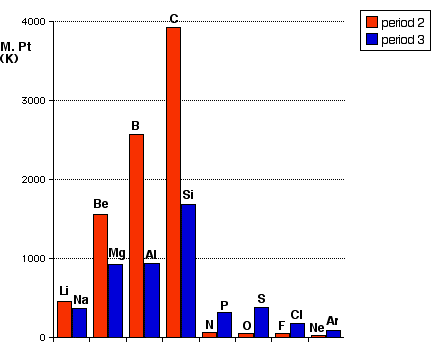|
Chemguide: Support for CIE A level Chemistry Learning outcomes 9.1(a), 9.1(b) and 9.1(c) These statements ask you to be able to describe and explain the variations in a number of basic properties of the elements as you go across Period 3 of the Periodic Table from sodium to argon. I am treating these statements together, because it doesn't make sense to look at the variation in each property separately from its explanation. Before you go on, you should find and read the statements in your copy of the syllabus. Atomic radius Start by reading the page atomic and ionic radii as far as (but not including) the trends in the transition elements. You won't need that until much later in the course. Notice that the trend in Period 3 is just the same as the one in Period 2, although of course the Period 3 elements are all bigger. This is what is meant in the syllabus by "periodicity". The same pattern is repeating itself. Then find the atomic radius section on the page atomic and physical properties of period 3 elements for a brief summary of what you need to know for these statements. You will be referred back to this page several times later for other things. Ionic radius Go back to the page atomic and ionic radii and read the section on ionic radii - but don't read the section headed "The relative sizes of ions and atoms", and which continues to the end of the page. You don't need it, and you risk getting seriously confused. | |
|
Note: In fact CIE have asked about the relative sizes of atoms and ions in June 2012 paper 23 Q1(b). They asked you to compare the sizes of sodium, magnesium and aluminium ions with the sizes of the original atoms. They said that the ions are smaller because the nuclei have a greater attraction because they are attracting fewer electrons, and also accepted the removal of a complete layer of electrons. The sizes of the negative ions that they were asking about relative to the atoms are much more difficult to explain satisfactorily, for reasons that I have gone into at length at the bottom of the page you have just read. What they accepted for 2 marks was "anions contain more electrons than the corresponding atoms, or anions contain more electrons than they do protons; nucleus has a smaller attraction". So if they ask something similar in the future, that is what you tell them. | |
|
If you compare the values for ionic radii that I quote on that page for Period 3 elements with the ones in the table towards the end of the CIE syllabus, you will find that some of them are different. You will see that I have quoted the source of my data on the page. I have no idea where the CIE data comes from. Don't worry about this - trying to get consistent and reliable data for ionic radii is a nghtmare. It doesn't affect the trends, and obviously, in an exam, you will have the CIE data available to you in the Data Booklet. You will also find that the CIE Data Booklet lists a 4+ silicon ion. This is slightly strange, because as far as I am aware, this ion doesn't exist! Melting points Then find the melting (and boiling) points discussed towards the bottom of the page atomic and physical properties of period 3 elements, but you should read the earlier section about the structures of the elements first. You can't understand the stuff about melting points unless you first understand the structures of the elements. Notice that I prefer the term "giant covalent" for structures like silicon, rather than "giant molecular" which CIE use. It would obviously make sense for CIE students to get used to the term you will meet in your exams. Melting points show good periodicity, in the sense that the pattern in Period 2 appears again in Period 3. This doesn't really fit in anywhere else on Chemguide, so here is an additional bar chart showing that:
You will see that the general pattern repeats in the two periods, although the detail doesn't. Both periods show the melting point increasing to Group 4, and then a steep drop. Although it isn't very difficult, explaining the differences between the two periods would actually take quite a long time, and is irrelevant to these statements (which are solely about Period 3) - so I am not going to confuse you with it. Electrical conductivity You may already have read this on the page atomic and physical properties of period 3 elements while you have been looking at some of the other things on this page. You will find it just above the section on melting and boiling points.
© Jim Clark 2010 (modified August 2013) |
|
